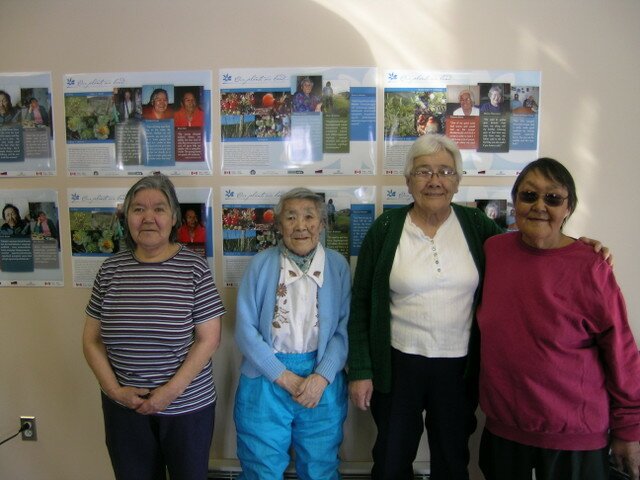Project Overview
The “Our Plants Our Land” research project has successfully recorded the traditional knowledge and language surrounding plants, and a wealth of information concerning climate change impacts and indicators of its influence on berries, vegetation, animals, local environment and Inuit traditional activities in Nain, Nunatsiavut. This community-based research project has successfully combined semi-structured interviews, field research and monitoring, and an Elder guided youth workshop to accomplish its goals. Throughout the process, community members have been intimately involved in all aspects of the project as researchers, translators, interview participants and teachers. The team has synthesized and disseminated research results and emphasized the importance of making them readily accessible to all Nain residents. Facilitating the production of common language outputs, both written and interactive have helped to successfully translate research into improved community wellbeing.
Traditional Knowledge
At the outset, the team turned to Elders in the community for their valuable input. General interview topics included changes in plant communities (i.e. distribution, growth, taste), berries, weather and the seasons as well as the traditional uses and naming of plants. Community members also mapped the locations of observed changes onto topographic maps of the region. Later, the team broadened their understanding of plants looking towards the meaning of Inuit plant and habitat names and the traditional description of those habitats within the landscape.
This traditional ecological knowledge is linked with previous information furthering the implications for future land use, conservation and sustainable development. The voices of participants have been captured as quotes in a booklet entitled “The Our Plants Our Land, Community of Nain, Labrador Plant Uses Booklet”. This is a not for profit publication that is currently in press for community distribution. The booklet also summarizes an Elder-youth workshop that took place in September 2010. To further pay tribute to the participants, posters with pictures and quotations from interviews have been compiled. The posters have been displayed around town, so that they can be shared with everyone in Nain.
The Elder-youth Plant workshop served to combine traditional knowledge and science in the form of a “green class” taught by Elders and facilitated by the research team. The two day workshop began on Sept 15, 2010 and was an all day excursion to Paul’s Island during which participants benefitted from fresh air and incredible sunshine. After a boat ride to the island from Nain in the morning, students teamed up with researchers to find plants. Later students brought the plants back to the beach where Elders were waiting to share their knowledge of use and stories about them and the past. Students took notes that they would use the following day. Afterwards everyone continued to bond over a traditional “boil up” lunch and games played during the boat ride home. The following morning, plants were grouped and the sharing continued at the Nunatsiavut Government building. Once Elders felt they had fully shared their knowledge of plants, participants discussed the impact of the workshop.
The consensus was that it was an enjoyable experience that allowed Elders and youth to reconnect with each other and the land. Elders left to enjoy the rest of their day and students returned in the afternoon. Researchers worked with students showing them how to press and dry plants for the initiation of Nain’s first herbarium (plant library) collection. The activities and plant pressing method taught during the workshop are also captured in the plant uses booklet so that participants have a lasting keepsake of the day’s activities.
Field Research and Monitoring
Simultaneous with interviews, fieldwork has been taking place in Nain. The research team is using small greenhouses called “open top warming chambers” to understand how changing climate will affect tundra plants, including berry shrubs and some of the plants eaten by caribou, such as lichens. They are also measuring markers of climate change such as increased temperature and changes in precipitation. Snow measurements taken in winter 2011 complement these data. The goal is to try to describe how plant communities are responding to current climate conditions and to predict how they might change with future climate change and impact Inuit health. These field data are complemented by the interviews previously mentioned on climate change and will be available in the form of a booklet available in English and Inuktitut.





Photo Credits: Alain Cuerrier, Ashleigh Downing, and Jason Dicker
Successes
The research team has worked to synthesize and disseminate results and make the outcomes of research more accessible to all community members. Community outputs are at the heart of the team’s success. Interactive outputs included an “Elder guided plant uses workshop” and a well attended “Community information session” in winter 2011 summarizing progress. These outputs allowed participants to learn, get updated, offer input and get answers to their questions. Participant recommendations from these meetings have been incorporated in our work. Educational and written outputs include herbarium specimens made by local students, a plant identification book, workshop summary and plant use booklet, climate change observations booklet, and community posters that showcase local Elders and their knowledge of plants, plant uses and environmental changes in their homeland.
Community involvement in research design, implementation and data interpretation enrich results and give them meaning and value at the community level. Youth from Nain have participated in fieldwork, learning while helping researchers with their tasks. All of these activities support the translation of knowledge into increased community wellbeing by strengthening cultural identity and environmental adaptability for the future.
Acknowledgments
This community based research program also benefited from related funding from Health Canada, International Polar Year-CiCAT, ArcticNet and NSTP.






